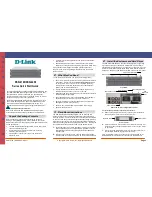
LaCie 2big Quadra
•
DESIGN BY NEIL POULTON
Setup
User Manual
page 20
3.4. Formatting
The 2big Quadra comes pre-formatted in HFS+ (optimized for
Mac OS X). Please read the following information on file system
formats for Windows and Mac operating systems to determine
if you need to reformat the 2big’s disks. See sections
3.4.2
and
3.4.3
for formatting instructions.
3.4.1. File System Formats
Windows Users
The 2big Quadra comes pre-formatted in HFS+ (optimized for
Mac OS X).
TECHNICAL NOTE:
Windows XP 32-bit and Windows 2000
do not support volumes greater than 2TB. Windows XP x64,
Windows Server 2003 SP1, and Windows Vista Enterprise/Ul-
timate (32- and 64-bit versions) do, but in order to create vol-
umes bigger than 2TB from these operating systems, you must
convert the disk to GPT file system. This process is outlined in
3.4.2. Formatting for Windows Users
.
FAT 32
FAT is an acronym for File Allocation Table, which dates back
to the beginnings of DOS programming. Originally, FAT was
only 16 bits, but after the second release of Windows 95 it was
upgraded to 32 bits, hence the name FAT 32. In theory, FAT 32
volume sizes can range from less than 1MB all the way to 2TB. It
is the native file system of Windows 98 and Windows Me, and is
supported by Windows 2000, Windows XP and Windows Vista.
When FAT 32 is used with Windows 2000, Windows XP and
Windows Vista though, volume size is limited to 32GB (by the
Windows partition utility, i.e. Disk Manager), and the individual
file size is limited to 4GB.
NTFS
This acronym stands for New Technology Filing System, and it
is the native file system for Windows NT, Windows 2000, Win-
dows XP and Windows Vista. NTFS offers several features that
are not available with FAT 32; i.e. file compression, encryption,
permissions, and auditing, as well as the ability to mirror drives
and RAID 5 capabilities. The minimum supported volume size for
NTFS is 10MB, with a maximum of 2TB when initialized in MBR
format or without a limit when initialized in GPT format, with no
limit to file size. Volumes created in NTFS can only be directly
accessed (not through shares) by Windows NT, Windows 2000,
File System Formats
There are two different file system formats compatible with
Windows operating systems – NTFS and FAT 32 (MS-
DOS). Use the information below to determine which for-
mat is best for you.
Use NTFS if…
...you will be using the drive only with Windows 2000,
Windows XP or Windows Vista (performance will generally
be greater when compared to FAT 32). This file system is
compatible in read only mode with Mac OS X 10.3 and
higher. See technical note at left for information on the
2TB volume size limitation under Windows XP 32-bit and
Windows 2000.
Use FAT 32 (MS-DOS) if…
...you will be using your drive with both Windows and Mac
OS X 10.3 or sharing the drive between Windows 2000
and Windows XP or Windows Vista. Maximum single file
size is 4GB.
















































